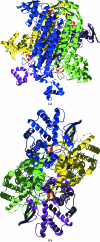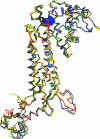Structure of fumarate hydratase from Rickettsia prowazekii, the agent of typhus and suspected relative of the mitochondria
- PMID: 21904061
- PMCID: PMC3169413
- DOI: 10.1107/S174430911102690X
Structure of fumarate hydratase from Rickettsia prowazekii, the agent of typhus and suspected relative of the mitochondria
Abstract
Rickettsiae are obligate intracellular parasites of eukaryotic cells that are the causative agents responsible for spotted fever and typhus. Their small genome (about 800 protein-coding genes) is highly conserved across species and has been postulated as the ancestor of the mitochondria. No genes that are required for glycolysis are found in the Rickettsia prowazekii or mitochondrial genomes, but a complete set of genes encoding components of the tricarboxylic acid cycle and the respiratory-chain complex is found in both. A 2.4 Å resolution crystal structure of R. prowazekii fumarate hydratase, an enzyme catalyzing the third step of the tricarboxylic acid cycle pathway that ultimately converts phosphoenolpyruvate into succinyl-CoA, has been solved. A structure alignment with human mitochondrial fumarate hydratase highlights the close similarity between R. prowazekii and mitochondrial enzymes.
Figures





Similar articles
-
The genome sequence of Rickettsia prowazekii and the origin of mitochondria.Nature. 1998 Nov 12;396(6707):133-40. doi: 10.1038/24094. Nature. 1998. PMID: 9823893
-
Structure of 3-ketoacyl-(acyl-carrier-protein) reductase from Rickettsia prowazekii at 2.25 Å resolution.Acta Crystallogr Sect F Struct Biol Cryst Commun. 2011 Sep 1;67(Pt 9):1118-22. doi: 10.1107/S1744309111030673. Epub 2011 Aug 16. Acta Crystallogr Sect F Struct Biol Cryst Commun. 2011. PMID: 21904060 Free PMC article.
-
Bioenergetics of the obligate intracellular parasite Rickettsia prowazekii.Biochim Biophys Acta. 1998 Jun 10;1365(1-2):105-11. doi: 10.1016/s0005-2728(98)00050-4. Biochim Biophys Acta. 1998. PMID: 9693729 Review.
-
Progress in rickettsial genome analysis from pioneering of Rickettsia prowazekii to the recent Rickettsia typhi.Ann N Y Acad Sci. 2005 Dec;1063:13-25. doi: 10.1196/annals.1355.003. Ann N Y Acad Sci. 2005. PMID: 16481486 Review.
-
The Rickettsia prowazekii genome: a random sequence analysis.Microb Comp Genomics. 1996;1(4):293-315. Microb Comp Genomics. 1996. PMID: 9689214
Cited by
-
Recent molecular insights into rickettsial pathogenesis and immunity.Future Microbiol. 2013 Oct;8(10):1265-88. doi: 10.2217/fmb.13.102. Future Microbiol. 2013. PMID: 24059918 Free PMC article. Review.
-
Crystal structure of an Fe-S cluster-containing fumarate hydratase enzyme from Leishmania major reveals a unique protein fold.Proc Natl Acad Sci U S A. 2016 Aug 30;113(35):9804-9. doi: 10.1073/pnas.1605031113. Epub 2016 Aug 15. Proc Natl Acad Sci U S A. 2016. PMID: 27528683 Free PMC article.
References
Publication types
MeSH terms
Substances
Associated data
- Actions
Grants and funding
LinkOut - more resources
Full Text Sources

